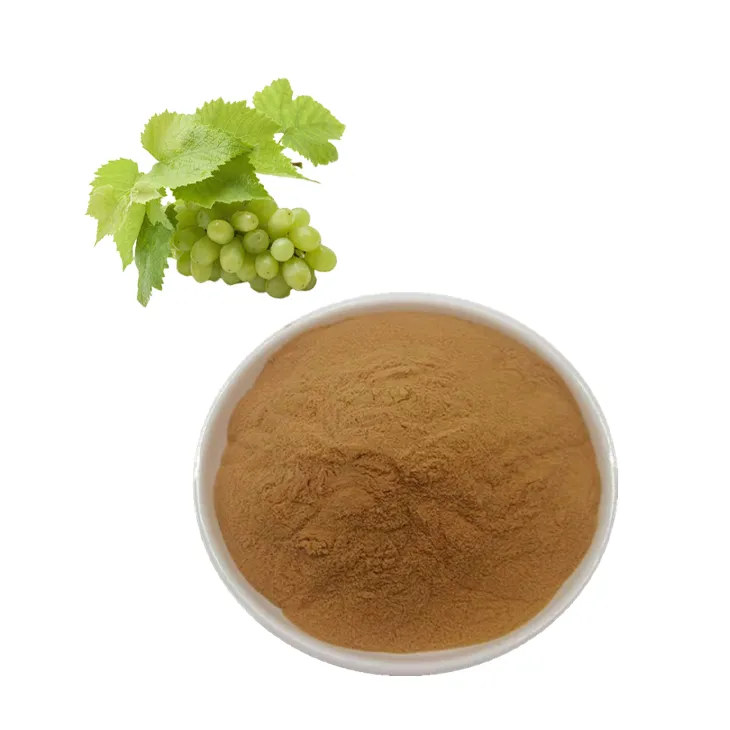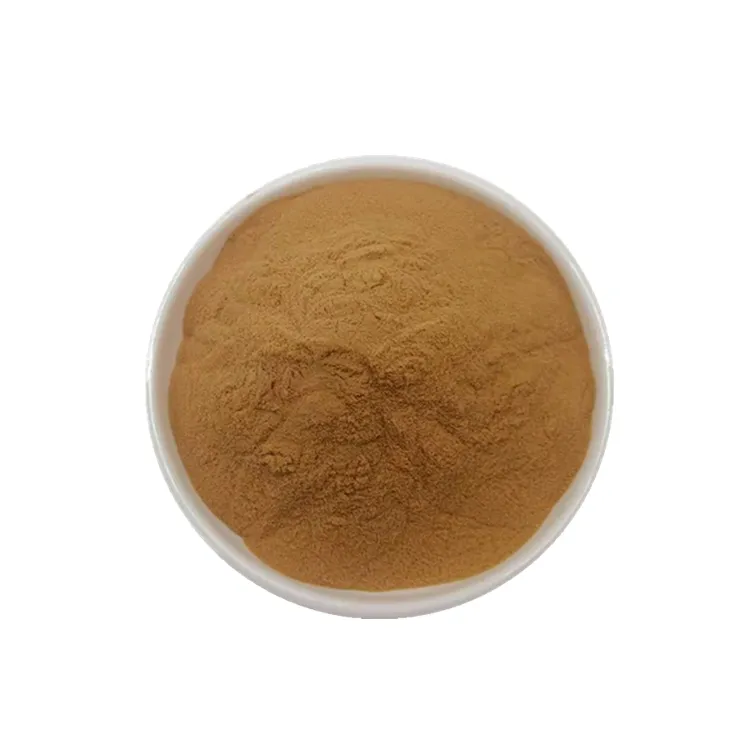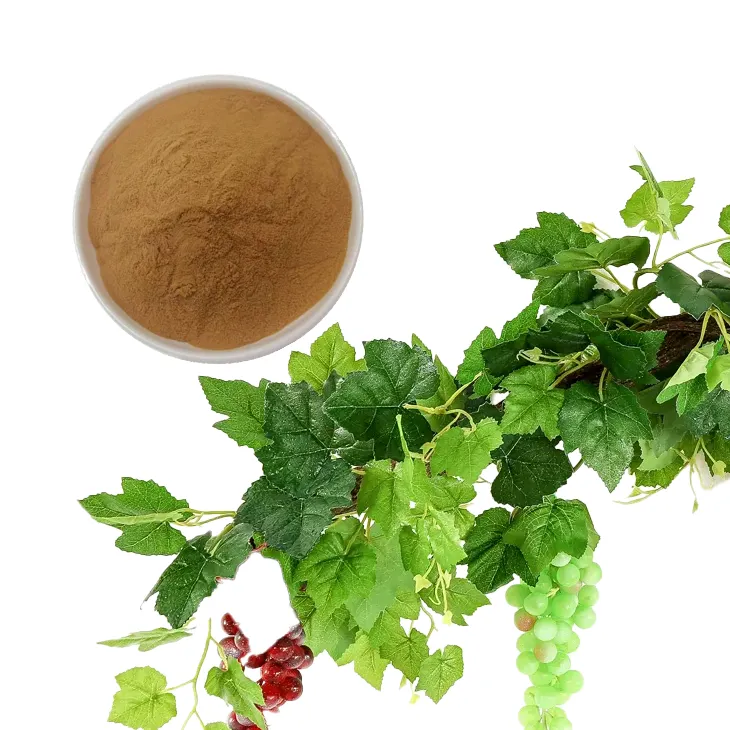- 0086-571-85302990
- sales@greenskybio.com
Grape Leaf Extract: Uses, Advantages and Manufacturing Processes
2024-11-14

1. Uses of Grape Leaf Extract
Grape Leaf Extract has a wide range of uses across different fields.
1.1 In Traditional Medicine
For centuries, Grape Leaf Extract has been an important part of traditional medicine. It has been used to treat various ailments. For instance, it is believed to play a role in improving digestion. This is because it may potentially stimulate the secretion of digestive enzymes, which are crucial for breaking down food and absorbing nutrients. In some traditional medicine systems, grape leaf extract has also been used for its anti - inflammatory properties. It might be applied topically to soothe skin inflammations or taken internally to reduce inflammation in the body.
1.2 In the Field of Nutraceuticals
In the world of nutraceuticals, grape leaf extract is a highly valuable ingredient. It can enhance the overall nutritional profile of products. Nutraceuticals are products that combine the benefits of nutrition and pharmaceuticals, and grape leaf extract fits well into this concept. It contains a variety of bioactive compounds such as polyphenols, which are known for their antioxidant properties. These antioxidants can help to neutralize free radicals in the body, which are associated with various diseases and the aging process. By adding grape leaf extract to nutraceutical products, manufacturers can offer consumers a more comprehensive and health - promoting option.
1.3 In the Agricultural Sector
The application of grape leaf extract in the agricultural sector is also quite promising. It shows potential as a natural pesticide. Many synthetic pesticides have negative impacts on the environment and human health. Grape leaf extract, on the other hand, offers a more sustainable alternative. It can protect plants from certain pests, either by repelling them or interfering with their life cycles. For example, some studies have shown that certain compounds in grape leaf extract can disrupt the feeding or reproductive behavior of pests, reducing their impact on crops.

2. Advantages of Grape Leaf Extract
The advantages of grape leaf extract are extensive and contribute to its growing popularity in various industries.
2.1 Environmentally Friendly
As a natural product, grape leaf extract is highly environmentally friendly. In contrast to many synthetic chemicals, it does not leave harmful residues in the environment. When used as a pesticide in agriculture, it does not contaminate soil, water sources, or the surrounding ecosystem. It also has a lower impact on non - target organisms, such as beneficial insects and soil microorganisms. This is crucial for maintaining the balance of the ecosystem and promoting sustainable agricultural practices.
2.2 Cost - Effective Alternative
Grape leaf extract serves as a cost - effective alternative to some synthetic chemicals in different industries. In the nutraceutical industry, for example, the production of synthetic antioxidants can be expensive. Grape leaf extract, which contains natural antioxidants, can be a more affordable option without sacrificing quality. In the agricultural sector, the cost of developing and using new synthetic pesticides is constantly rising. Natural alternatives like grape leaf extract can provide a more economical solution for pest control, especially for small - scale farmers who may have limited budgets.
2.3 Broad Spectrum of Biological Activities
The chemical composition of grape leaf extract, which includes a variety of polyphenols, gives it a broad spectrum of biological activities. Polyphenols are a large group of compounds with diverse functions. They can act as antioxidants, anti - inflammatories, and antimicrobial agents. This versatility makes grape leaf extract a very useful ingredient. It can be used in multiple applications, from promoting human health in nutraceuticals to protecting plants in agriculture. For example, the antioxidant activity of polyphenols in grape leaf extract can help prevent oxidative damage in both human cells and plant tissues.

3. Manufacturing Process of Grape Leaf Extract
The production of grape leaf extract involves several carefully controlled steps to ensure the quality and potency of the final product.
3.1 Selection of Grape Leaves
The process starts with the selection of high - quality grape leaves. It is preferable to choose leaves from organically grown grapes. Organic grapes are grown without the use of synthetic pesticides and fertilizers, which reduces the risk of chemical contamination in the extract. The leaves should be healthy, free from diseases and pests, and harvested at the appropriate time. The quality of the leaves directly affects the quality of the extract, so this initial step is crucial.
3.2 Drying Process
After selection, the grape leaves are then subjected to a drying process. There are different methods for drying, such as air - drying or low - temperature drying. Air - drying is a traditional method that involves spreading the leaves in a well - ventilated area and allowing them to dry naturally. This method is simple and cost - effective but may take longer. Low - temperature drying, on the other hand, uses specialized equipment to dry the leaves at a controlled low temperature. This method can be faster and more efficient in preserving the active components of the leaves. The purpose of drying is to reduce the moisture content of the leaves, which helps to prevent the growth of mold and bacteria and also makes it easier to grind the leaves into a powder.
3.3 Grinding into Powder
Once the leaves are dried, they are ground into a fine powder. This step is important as it increases the surface area of the leaves, which is beneficial for the subsequent extraction process. The powder should be as fine as possible to ensure maximum extraction efficiency. Grinding can be done using various types of grinding equipment, such as a mortar and pestle for small - scale production or a high - speed grinder for larger - scale operations.
3.4 Extraction
After grinding, extraction is carried out. There are different extraction methods available. One common method is to use green solvents like ethyl acetate. Green solvents are preferred because they are less toxic and more environmentally friendly compared to some traditional solvents. Ethyl acetate can effectively dissolve the active components in the grape leaf powder. Another method is enzymatic extraction. This involves using specific enzymes to break down the cell walls of the grape leaf powder, releasing the active compounds. Enzymatic extraction can be a more targeted and gentle method, which may preserve the integrity of the bioactive compounds better.
3.5 Filtration and Concentration
Once the extraction is complete, the resulting extract is then filtered and concentrated. Filtration is necessary to remove any solid particles or impurities from the extract. This can be done using various types of filters, such as filter paper or membrane filters. After filtration, the extract is concentrated to increase the concentration of the active components. Concentration can be achieved through methods like evaporation under reduced pressure. The final product is a pure and potent grape leaf extract that can be used in various applications as described earlier.

FAQ:
What are the main uses of grape leaf extract in traditional medicine?
In traditional medicine, grape leaf extract has been used for centuries to treat various ailments. One of its main uses is to improve digestion as it may stimulate the secretion of digestive enzymes.
How does grape leaf extract act as a natural pesticide?
The specific mechanisms by which grape leaf extract acts as a natural pesticide are not fully understood yet. However, it shows potential in protecting plants from certain pests in the agricultural sector. Its chemical composition, which includes a variety of polyphenols, might be related to this pesticidal activity.
What makes grape leaf extract a cost - effective alternative in different industries?
Grape leaf extract is a cost - effective alternative in different industries because it can replace some synthetic chemicals. As a natural product, its production may involve less complex and costly processes compared to the synthesis of some artificial substances. Also, it is widely available from grape leaves, which are a by - product in the grape - related industries, reducing the cost further.
What is the significance of the polyphenols in grape leaf extract?
The polyphenols in grape leaf extract are of great significance. They give the extract a broad spectrum of biological activities. This makes the grape leaf extract a versatile ingredient in various fields such as nutraceuticals, where it can enhance the overall nutritional profile of products.
How is the drying process important in the manufacturing of grape leaf extract?
The drying process is crucial in the manufacturing of grape leaf extract. It is necessary to preserve the active components of the grape leaves. Air - drying or low - temperature drying is used to ensure that the valuable substances in the leaves are not damaged or lost during this stage, which is a key step before grinding and extraction.
Related literature
- The Bioactive Compounds in Grape Leaf Extract and Their Health Benefits"
- "Grape Leaf Extract: A Promising Natural Ingredient in Agriculture"
- "Manufacturing and Quality Control of Grape Leaf Extract"
- ▶ Hesperidin
- ▶ citrus bioflavonoids
- ▶ plant extract
- ▶ lycopene
- ▶ Diosmin
- ▶ Grape seed extract
- ▶ Sea buckthorn Juice Powder
- ▶ Beetroot powder
- ▶ Hops Extract
- ▶ Artichoke Extract
- ▶ Reishi mushroom extract
- ▶ Astaxanthin
- ▶ Green Tea Extract
- ▶ Curcumin Extract
- ▶ Horse Chestnut Extract
- ▶ Other Problems
- ▶ Boswellia Serrata Extract
- ▶ Resveratrol Extract
- ▶ Marigold Extract
- ▶ Grape Leaf Extract
- ▶ blog3
- ▶ blog4
- ▶ blog5
-
Organic Tongkat Ali extract powder factory.
2024-11-14
-
How to make powder with ashwagandha extract.
2024-11-14
-
Rosehip extract manufacturers from China.
2024-11-14
-
The best cat's claw extract in nature.
2024-11-14
-
Chinese Dandelion Leaf Extract Suppliers.
2024-11-14
-
Curcuma Longa Extract
2024-11-14
-
Tongkat Ali Extract
2024-11-14
-
Black Pepper Extract
2024-11-14
-
Lemon Balm Extract
2024-11-14
-
Tongkat Ali Extract Powder
2024-11-14
-
Hawthorn powder
2024-11-14
-
Licorice Root Extract Powder
2024-11-14
-
Aguaje Extract
2024-11-14
-
Ginseng Root Extract
2024-11-14
-
Aminolevulinic acid
2024-11-14





















